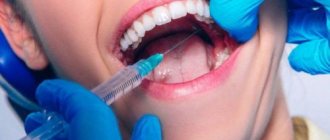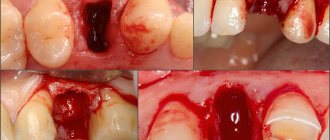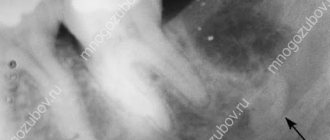31.10.2019
Painful sensations during dental treatment are a thing of the past. This was achieved through the use of painkillers. The use of anesthesia in dentistry allows complex procedures to be performed without fear for the patient’s sensations.
But at the same time, the patient has questions about how dental anesthesia works, how long the numbness goes away, and whether there may be side effects or allergic reactions. In most cases, after going to the dentist, unpleasant consequences arose precisely because of the weak effect of anesthesia.
How long does dental anesthesia wear off?
How long the anesthesia wears off on a tooth during treatment depends on the type of drug used:
- Applied to the surface of the mucous membrane, they act within a few minutes. They are used as a preparatory anesthetic, for example, to reduce pain when an anesthetic is injected into the gum. Comes off quickly;
- When anesthetizing the upper part of the dentition, the drug can act for up to 2.5 hours. How long the anesthesia wears off also depends on the individual characteristics of the patient;
- When intervening in the lower jaw area, stronger anesthesia is required, which takes longer. Therefore, the drug is injected deeper. As a result, the analgesic effect lasts up to four hours. The area of the jaw that needs to be anesthetized also plays a big role.
Only a dentist will tell you exactly how much anesthesia acts on a tooth during treatment; only he knows the dosage and effect of the specific drug that will be used.
The use of painkillers during most dental procedures has long become the norm. General anesthesia, the use of which puts a person into a state of artificial sleep, is rarely used; other methods are usually used. This requires special indications or major surgery.
General anesthesia is indicated in the following cases:
- mental disorders of the patient;
- risk of epileptic seizure;
- pathological fear of dental procedures;
- complexity of the dental procedure.
The scope of application of local anesthesia is much wider. This method is based on the fact that the drugs used block the conduction of nerve endings, thereby relieving the sensation of pain.
Anesthesia has practically replaced the previously used method of providing anesthetic care, based on the use of arsenic to eliminate nerve endings in the dental canal.
What does this depend on?
How long the dental anesthesia takes to wear off depends on the following factors:
- Inflammatory lesions at the injection site. The active elements of painkillers have an alkaline environment, and the localized inflammatory process forms an acidic environment. As a result of their interaction, the alkaline composition of the anesthetic is neutralized, and the anesthesia of the tooth wears off very quickly or does not occur. Therefore, the doctor must carefully calculate the amount of anesthesia, since numbness in such patients goes away much faster.
- The presence in the anesthesia formulation of elements that lead to vasoconstriction. It enhances the effect of the pain reliever. The anesthetic effect occurs later, but at the same time its duration increases, the freezing goes away more slowly.
- Patient's age. The older the patient, the more difficult it is to provide pain relief. At the same time, the process of weakening the anesthetic effect also lasts longer.
- Diseases of the digestive system (diseases of the gastrointestinal tract). Anesthesia is eliminated from the body by the liver and kidneys. Their level of health significantly affects how long tooth frost lasts and how it goes away.
- The duration of the effect of the anesthetic drug depends on the qualifications of the specialist who performed the procedure. If the technique is violated, either prolonged anesthesia or its complete absence occurs; it is very difficult to predict how the anesthesia will wear off.
Types of anesthesia
In modern dentistry, as a rule, two types of anesthesia are used:
- Local.
- Intravenous sedation.
Local anesthetics are the most common treatment for pain relief during dental procedures. They allow you to numb the local area of the oral cavity where the operation will be performed. However, the area of action of such drugs usually affects not only the tooth, but also adjacent tissues. For example, often after the administration of an anesthetic, numbness of the tongue, lips or cheek area appears.
Intravenous sedation is a treatment during sleep, when the patient is half asleep under the influence of drugs. The anesthesiologist carefully selects a prescription regimen taking into account your situation and your tests. It is important to clarify that this is not anesthesia in the form by which we understand it - the operation is carried out in a dental clinic, the patient breathes on his own and a couple of hours after the manipulation can go home; more details about sedation are written here. Indications for treatment under sedation will be:
- Severe fear in adults and children of dental surgery.
- For epilepsy.
- If the procedure takes a long period of time.
- Allergic reactions to topical drugs.
Any type of painkiller loses its effect over time, returning the body to its original state. The duration of action depends on the following factors:
- The nature of the substance.
- Method and correctness of drug administration.
- Individual characteristics of the patient.
- Place of injection.
Why does anesthesia not go away after dental treatment?
Sometimes the effect of the painkiller lasts longer than expected. The patient can try to reduce the effect of the anesthetic at home. To do this, apply a non-hot compress or massage to the site of anesthesia during the day. This will lead to expansion of the capillaries, which will speed up the removal of active substances from the anesthetized area, and the anesthesia will wear off faster.
In this case, you need to contact your doctor for advice. In addition, these measures are permissible if a filling is placed, but in no case after tooth extraction.
To ensure that the drug does not last longer than necessary, the patient’s liver should not be overloaded, since it is the liver that is responsible for removing the drug from the body. You should also not drink alcoholic beverages immediately after visiting the dentist.
Sometimes anesthesia may not go away due to complications. The main reason for the long-term effects of anesthesia is damage to the nerves of those organs where the zone of anesthesia was located. This may require the help of not only a dentist, but also a neurologist. This occurs both when the pain medication is administered incorrectly, and as a result of the treatment itself.
The prolonged effect of anesthesia should not create panic. The normal duration of anesthesia after injection of an anesthetic into the upper jaw is 2-3 hours, for the lower jaw - 4-5 hours.
If, during these standard dental procedures in the oral cavity, the tooth was anesthetized for a longer period of time, headaches, chills, or general malaise appeared, it is necessary to seek qualified help in a timely manner. The specialist will determine the cause and take measures to ensure that the anesthesia wears off in accordance with the norms.
Sometimes physical therapy may be necessary to eliminate negative symptoms. But cases where anesthesia takes too long to wear off are rare. Also, prolonged exposure to anesthesia is a result of the patient's hypersensitive reaction to the drug.
Content
After tooth extraction, an inflammatory process occurs in the soft tissues of the oral cavity - this is the main cause of edema and swelling. If the operation is performed correctly and the patient has followed all the dentist’s recommendations, the non-infectious inflammation will go away on its own, without antibiotics or complications, and along with it, pain and swelling will go away.
The duration of swelling varies depending on the surgical technique, which tooth was removed, the condition of the oral cavity, and finally, the physical condition of the patient and his immune system. On average, swelling lasts 3-4 days, but can last for 7 days. If after a week the swelling has not subsided, this is a sign of the development of complications and a reason to consult a specialist.
Swelling appears a few hours after surgery (after the anesthesia wears off). At the same time, the patient may feel aching pain, and ichor is released from the wound. A slight increase in temperature is allowed. All these symptoms are considered natural and do not pose any danger. And to relieve pain, you can take painkillers analgesics.
Maximum swelling is recorded on days 3-4, from this moment it begins to decrease and by the seventh day it completely disappears. But the cheek can swell immediately after depulpation; this happens if the patient had gumboil and the tumor developed even before the operation.
Extraction of extreme molars (wisdom teeth) is considered one of the most difficult tooth extraction operations. It is accompanied by an incision of soft tissues and suturing, so inflammation after it is inevitable. Swelling after wisdom teeth removal lasts longer and is accompanied by pain.
Moreover, an elevated temperature may persist for several days, the patient may have difficulty swallowing, and experience pain when opening the mouth and during speech.
In this case, there is a risk of infection and serious inflammation, therefore, after depulping the extreme molars, it is necessary to take antibiotics and rinse the mouth with antiseptic solutions.
Types of anesthetics and their features
Exactly how long anesthesia lasts after dental treatment depends on what type of anesthesia is used.
The following types of anesthesia are used in modern dentistry:
- Applique. The main feature is a short period of action. It is a gel or spray for surface use. Use is limited to a small number of procedures that do not require significant anesthesia for a long period. These drugs can be used as auxiliary drugs.
- Infiltration. Such anesthesia must be injected with a syringe into the area of bone tissue or periosteum. It is used for many procedures, including cleaning dental canals. Valid for an hour.
- Conductor. The product acts directly on the trigeminal nerve area. The injection may cause severe pain, which can be relieved with another anesthesia. Used to treat molars.
- Intraligamentary. It is aimed at a specific tooth for various procedures - chipping occurs around the diseased incisor. Used for tooth extraction or complex operations.
Articaine series
Articaine is a common painkiller used throughout the world. It is available in various forms and dosages, which allows you to choose the optimal anesthetic for the patient. It can be combined with medications of the adrenaline group, which allows you to narrow blood vessels and prevent possible blood loss.
This anesthetic is stronger in effect than traditional painkillers: five to six times than lidocaine and two to three times than novocaine. Anesthesia can be performed in such a way that it will not harm either patients with contraindications or pregnant and lactating women.
The duration of tooth freezing can be selected so that the anesthesia after tooth treatment begins to wear off immediately after the end of the intervention and does not cause discomfort.
Mepivacaines
This is a special group of anesthetics that does not require combination with adrenaline. Due to this, it is less effective. But thanks to its formula, it can be prescribed for the treatment of pregnant women, patients with cardiovascular diseases and is used to treat children.
It is used in dentistry not only during treatment and procedures, but also to reduce pain after their completion, for example, as painkillers after wisdom tooth removal. The use of the drug allows you to painlessly treat severe cases of dental diseases.
It has contraindications, so before use a sensitivity test is required, which will determine how long the effect will take and how the patient will tolerate anesthesia.
What can I do to make the anesthesia wear off faster?
If the patient does not want the anesthesia to wear off for a long time and cause unnecessary discomfort, you can follow simple tips:
- When planning a trip to the dentist, you should exclude fatty foods and alcohol from your diet. This will help relieve the liver and other glands that produce secretions to speed up metabolism. Thus, the anesthetic will be removed from the body faster, and the frozen area will recover from anesthesia more quickly. It is worth limiting the intake of medications except for those that are necessarily prescribed by the doctor and the refusal of which can lead to negative consequences.
- After minor dental procedures, significant volumes of liquid and massage of the freezing zone will help relieve anesthesia.
- In case of complex operations, on the contrary, it is necessary to exclude impact on the place where the intervention took place. Eating food and liquids is possible no earlier than four to five hours later.
If the numbing, pain-relieving effect does not subside for quite some time after visiting the dental office, this may indicate that a nerve has been affected. In this case, you should consult a doctor for additional help and advice to avoid negative consequences.
Before going to an appointment, each patient at a dental clinic must be sure that there are no allergic reactions to anesthesia. Otherwise, before using anesthesia, the doctor must conduct testing by administering a small dose of the drug. This will allow you to get rid of possible problems and side effects after visiting the dentist.
Category: Tooth extraction Published by Mister stomatolog










